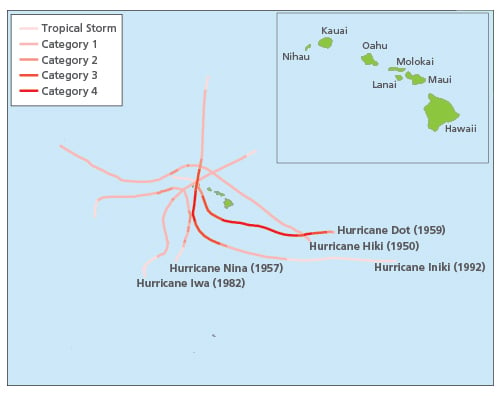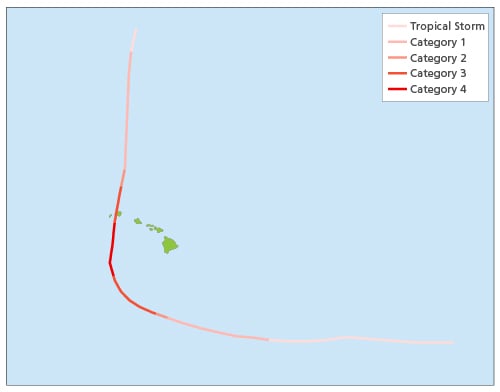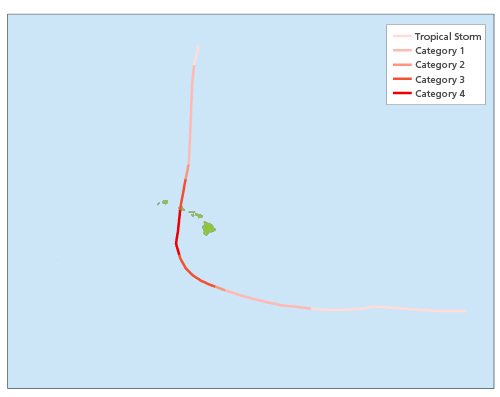Whats the Chance That Kauai Might Experience Another Hurricane Such as Iniki Again?
Editor'southward Note: This month marks the 20th anniversary of Hurricane Iniki, the about destructive in Hawaii'south history. In this article, Scott Stransky, a Senior Scientist in AIR's Research and Modeling group, discusses hurricane risk in Hawaii.
Xx years agone, the most powerful storm to strike the Hawaiian Islands in recorded history made landfall on the island of Kauai on September eleven, 1992. With sustained winds of 140 miles per hour, Hurricane Iniki pummeled Kauai and acquired damage in the nearby island of Oahu equally well. In all, Iniki inflicted billions of dollars of belongings damage on the state of Hawaii, leaving over xiv,000 homes damaged or destroyed.
Hurricanes seldom affect Hawaii, and strong ones similar Iniki are even rarer. But given the strength of Hurricane Iniki and the scope of the damage information technology inflicted, how concerned should residents and insurance companies be nigh hurricane take a chance in Hawaii? In this article, nosotros evaluate tropical whirlwind risk in the Central Pacific bowl, summarize Iniki's characteristics and furnishings, and use the updated AIR Tropical Whirlwind Model for Hawaii (scheduled for release in 2013 in Version 15.0 of AIR's software products) to estimate the damage an Iniki-like storm could cause if information technology were to strike the state'southward capital city of Honolulu.
Hurricane Chance in the Central Pacific Basin
In the Primal Pacific basin, tropical cyclones that can potentially affect Hawaii are spawned past warm bounding main waters near the equator, including coastal waters near Mexico and Central America. These storms are and then pushed past the trade winds northwest across the Central Pacific.
Storm germination is most common between June and November, when vertical wind shear is low, body of water surface temperatures are warm, and other favorable conditions are more likely to exist nowadays. But, simply how common are these "right" weather condition?
The tropical Pacific shifts between the two phases of the El Niño-Southern Oscillation (ENSO) every 3-4 years, leading to an average of two or three periods of enhanced hurricane adventure in Hawaii per decade (meet sidebar). Very few tropical cyclones, however, are known to have afflicted Hawaii. Hawaii is a very pocket-size "target" within the vastness of the Pacific Body of water, which reduces the probability of landfall.
Indeed, since reliable record keeping began in the 1950s, Hawaii has, on average, been affected by just one damaging tropical cyclone per decade. The tracks and Saffir-Simpson categories of the five nearly pregnant tropical cyclones to affect Hawaii since 1950 are shown in Figure 1 (annotation that the colors show how each storm intensified or weakened throughout its lifespan).

Of course, hurricanes take been causing damage in Hawaii long before official records were kept. For example, eyewitness1 reports of the 1871 Kohala cyclone, a storm that hit the island of Maui, vividly describe the devastation:
"…whole trees might be seen pirouetting and [galloping] down i street and up some other, while the horrible roar of the gale, now shrieking like 5000 steam whistles let off at once, now becoming like a magnificent thunder kept up with music to the mad performance…Add to that an inveterate rain that knew no ceasing from early morn to late at nighttime and you might have an thought of a tropical storm in Lahaina."
"In our garden there is scarcely a whole tree of whatsoever kind remaining. A mango tree xv inches in diameter was snapped every bit a pipe stem, just to a higher place the surface of the ground. Old solid kukui trees which had stood the storms of scores of years were torn up and pitched about similar crust…"
Hurricane Iniki: Characteristics and Effects
On September 5, 1992, the tropical depression that would go Hurricane Iniki took shape about 1600 miles southwest of Baja California. The organisation intensified as it tracked w across the Key Pacific, reaching hurricane strength on September 9, nearly 470 miles southeast of Hilo, on the island of Hawaii (see Figure 1 and Figure 2). Over the course of the following day, Hurricane Iniki turned sharply toward the due north, steered by increased southerly menstruation of local winds, putting the storm on a direct path for Kauai. When Hurricane Iniki fabricated landfall on Kauai on September 11, 1992, this modest but intense storm exhibited sustained winds of 140 miles per 60 minutes and gusts of upwardly to 175 miles per hour, making Iniki the most powerful storm to strike Hawaii in the officially recorded history.2

Although the south shore of Kauai experienced the worst harm from both wind and storm surge, harm was extensive over the whole island. Hurricane Iniki damaged or destroyed more fourteen,000 homes on Kauai; of these, more than 5,000 suffered major impairment and almost 1,500 residences were completely flattened. In all, near 90% of structures on Kauai were damaged. Hurricane Iniki also downed over 35% of the power lines on Kauai, inflicting a blackout over the entire island and wiping out nearly all communication systems. Crop impairment was significant, with important agricultural products such equally sugar pikestaff, papaya, and bananas suffering the worst furnishings.
If Hurricane Iniki were to strike today, AIR estimates that insured losses would exceed USD three billion.
Could a Storm Like Iniki Strike Honolulu?
Oahu, where Hawaii's capital metropolis of Honolulu is located, is the economic and cultural hub of Hawaii. A directly hurricane strike on this isle would have far-reaching furnishings on the land every bit a whole. Honolulu hosts many government offices and tourist attractions, and is home to more than 300,000 residents. Co-ordinate to AIR'south calculations, just over 70% of the exposure value on the Hawaiian Islands is located inside Honolulu. Waikiki, a major beach destination in Hawaii, is also located in the island of Oahu. Many economically important crops are grown on Oahu, including pineapples, coffee, and macadamia nuts.
Virtually one quarter of homes in Honolulu are characterized by single-wall structure, with lightweight metallic roofs, "tofu cake" foundation,three and low-cal outer cladding. These are particularly vulnerable to hurricane winds and are likely to experience the worst damage considering of weak connections between adjacent structural elements. Although stronger, more than wind-resistant double-walled homes (conventional timber frame structures) make up a much larger percent (about three quarters) of residences in Honolulu, these houses would not escape damage. For example, all buildings with large windows and garage doors—regardless of wall structure—were notably vulnerable to damage during Iniki.
The effects of an Iniki-like storm on Honolulu and the entire island of Oahu would certainly be significant and far-reaching. But is such a scenario realistic? Based on reports from the 1871 Kohala cyclone (described to a higher place), along with reports of several other hurricanes from the 1800s, AIR researchers have concluded that Iniki could have fabricated landfall on Maui or Oahu, instead of Kauai, under only slightly unlike steering weather. Furthermore, Iniki would have been simply as intense had it struck Maui or Oahu, instead of Kauai. The tempest'south track—and which island information technology eventually struck—depended mainly on when the tempest made its sharp turn toward the north, not on the storm'south strength or other parameters. In addition, anecdotal bear witness from the Kohala issue and other cyclones in the 1800s straight contradicts the pop conventionalities that Kauai is the only island vulnerable to Hawaiian hurricanes.
Modeling the Touch
To assess the impact of an Iniki-like storm on Oahu, the updated AIR Tropical Cyclone Model for Hawaii was used to conduct a sensitivity study. Specifically, AIR simulated a tempest identical to Hurricane Iniki in its meteorological parameters—including primal pressure, radius of maximum winds, and forward speed—only with a track that takes information technology to Oahu, about 100 miles eastward of Kauai (see Effigy 3).

Using the updated model, AIR calculates that the insured losses caused by a direct hit on Honolulu by this imitation event would approach USD 37 billion—over 11 times higher than the estimated losses from a recurrence of Hurricane Iniki. It should be noted that a similar event with a lower primal pressure, a larger radius of maximum winds, or a slower forrard speed could crusade even greater losses.
From a meteorological perspective, the probability of an Iniki-like event striking Kauai is similar to the almanac probability of an Iniki-like issue striking Oahu. Indeed, Professor Gary Barnes, a meteorologist from the Academy of Hawaii and one of the peer reviewers of AIR'due south updated model, wrote in his review that the new model "is assuming equal take chances across the islands. Whatsoever person or grouping that thinks otherwise is engaged in wishful thinking." The resulting losses, however, are strikingly different.
Conclusions
Although hurricanes seldom strike the Hawaiian Islands, residents of all of the islands and insurers should still be prepared for the devastation they can crusade. The updated AIR Tropical Cyclone Model for Hawaii (to be released in 2013) estimates that a tropical cyclone identical to Hurricane Iniki, if it were to strike Honolulu and Oahu, would inflict insured losses of nearly USD 37 billion. Other hypothetical events modeled on Hurricane Iniki could crusade even higher losses, for which the insurance industry must exist prepared.
ane Source: These eyewitness accounts were published in the August 22, 1871 issue of The Hawaiian Gazette. They are also quoted by NOAA hither: http://world wide web.prh.noaa.gov/cphc/summaries/1800s.php)
two In NOAA's HURDAT database.
3 A "tofu block" foundation means that, rather than resting on a concrete slab, a post and beam arrangement is used to support the first flooring. This means that the house stands on short wooden posts perched on concrete blocks, similar picayune stilts, leaving an air space between the house'southward floor and the basis.
Source: https://www.air-worldwide.com/publications/air-currents/2012/The-20th-Anniversary-of-Hurricane-Iniki--Assessing-Tropical-Cyclone-Risk-in-Hawaii/
0 Response to "Whats the Chance That Kauai Might Experience Another Hurricane Such as Iniki Again?"
Post a Comment